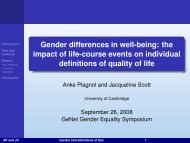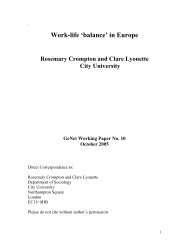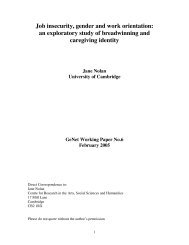Guidelines for Gender Equality Programmes in Science - GeNet
Guidelines for Gender Equality Programmes in Science - GeNet
Guidelines for Gender Equality Programmes in Science - GeNet
Create successful ePaper yourself
Turn your PDF publications into a flip-book with our unique Google optimized e-Paper software.
Graph 10 – Female contribution <strong>in</strong> technology sectors, EU-27 <strong>in</strong>ventors, 2001-2003 (%)<br />
16%<br />
14%<br />
12%<br />
10%<br />
14<br />
12<br />
8%<br />
6%<br />
6<br />
6<br />
5<br />
4%<br />
2%<br />
3<br />
3<br />
2<br />
0%<br />
Source: Busolt, Kugele, & T<strong>in</strong>sel, 2009<br />
of women <strong>in</strong>ventors with<strong>in</strong> these sectors is<br />
worry<strong>in</strong>gly low” (Busolt, Kugele, & T<strong>in</strong>sel,<br />
2009).<br />
Similar data are also provided by an analysis<br />
made by the American NCWIT ( N a t i o n a l<br />
Center <strong>for</strong> Women & In<strong>for</strong>mation Technology)<br />
on patents <strong>in</strong> the IT sector licensed by<br />
women <strong>in</strong> United States and Japan <strong>in</strong> the<br />
period 1980-2005 (when the patent was<br />
licensed by a mixed group, <strong>for</strong> each gender<br />
the respective fraction was attributed). Five<br />
percent of US patents were licensed by<br />
women (5.7% if the shorter 2000-2005 period<br />
was considered). In the case of Japan, the<br />
figure was 3% (Observa, 2008).<br />
Women’s under-representation <strong>in</strong> a wider<br />
context<br />
To better frame this set of data it is necessary<br />
to <strong>in</strong>troduce a further piece of <strong>in</strong>terpretation,<br />
l<strong>in</strong>k<strong>in</strong>g the issue of women’s leadership to the<br />
profound changes science and technology<br />
are go<strong>in</strong>g through, and the grow<strong>in</strong>g<br />
importance of some scientific professional<br />
roles and profiles.<br />
Obviously, pure scientific merit has never<br />
been, even <strong>in</strong> the past, the only criterion used<br />
to select leadership. There are other<br />
variables that <strong>in</strong>fluence career dynamics (e.g.<br />
political affiliations, personal networks or<br />
seniority). Even more important, as the<br />
French sociologist Pierre Bourdieu po<strong>in</strong>ted<br />
out, besides scientific power (related to<br />
scientific reputation, which manifests itself,<br />
e.g., <strong>in</strong> writ<strong>in</strong>g books and articles, citations,<br />
participation <strong>in</strong> sem<strong>in</strong>ars, conferences and<br />
workshops), scientific careers have always<br />
been determ<strong>in</strong>ed by scientists’ “t e m p o r a l<br />
power” (Bourdieu, 2001). This is l<strong>in</strong>ked to<br />
abilities such as <strong>in</strong>teract<strong>in</strong>g with publish<strong>in</strong>g<br />
houses, gett<strong>in</strong>g funds, manag<strong>in</strong>g research<br />
structures, <strong>in</strong>teract<strong>in</strong>g with <strong>in</strong>dustries and<br />
policy makers.<br />
This is to say that leadership <strong>in</strong> the scientific<br />
doma<strong>in</strong> has never been uniquely related to<br />
pure scientific talent, but also to other k<strong>in</strong>ds<br />
of capacities recognised as embedded <strong>in</strong> the<br />
“profession of scientist”.<br />
However, rapid and deep changes <strong>in</strong> the<br />
last decades have affected the way <strong>in</strong> which<br />
science is produced, communicated and<br />
exploited and the overall relationship<br />
between science and society. These changes<br />
have <strong>in</strong> turn altered the balance between<br />
“scientific” and “temporal power” roles,<br />
conferr<strong>in</strong>g more importance to the latter, and<br />
<strong>in</strong> particular to activities such as communication<br />
and fund-rais<strong>in</strong>g.<br />
As <strong>for</strong> the emerg<strong>in</strong>g trends <strong>in</strong> S&T<br />
production, they are so deep and rapid as to<br />
justify the idea of an overall shift from<br />
“academic” to “post-academic” science<br />
34






